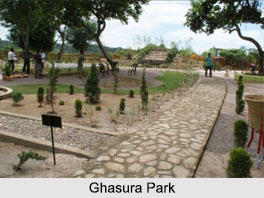 Ghasura Park is located near Ampati town on the banks of the Daru River in the South-West Garo Hills of Meghalaya. The park is ideal for a day"s recreation where there is an open sit out overlooking the Daru River, a pond and a rock garden with a waterfall. The park is beautifully laid out with flowerbeds, shrubs and trees. The setting of the park emits an atmosphere of tranquility and serenity.
Ghasura Park is located near Ampati town on the banks of the Daru River in the South-West Garo Hills of Meghalaya. The park is ideal for a day"s recreation where there is an open sit out overlooking the Daru River, a pond and a rock garden with a waterfall. The park is beautifully laid out with flowerbeds, shrubs and trees. The setting of the park emits an atmosphere of tranquility and serenity.
Etymology of Ghasura Park
Ghasura Park was named after Ghasui Bhoia, a name with significance of Bhoia "The Mighty one", a man who took this region and its people into modern civilization a century ago. The park is based on a Japanese Zen garden theme.
Project of Ghasura Park
The project of Ghasura Park was initiated by the Department of Tourism, Meghalaya in 2012. The park was formally inaugurated by Dr. Mukul Sangma, Chief Minister of Meghalaya in 2012.
Amenities of Ghasura Park
The entrance of Ghasura Park is at the east of the garden which is lined with silver pine barriers. Towards the south of the park, along a flagstone is a rock garden with date palm, natural Bonsai which are arranged with rocks, pebbles and sand. In the south-western part of the garden, there is a Gazebo overlooking the Daru River. In the west, there is a waterfall and in front of it is an open air amphitheatre. There is also a wooden bridge that crosses a small pool with crystal clear waters.
Ghasura Park is covered with the tropical evergreen offering tranquility and serenity to visitors. The presence of a large number of plants and trees attract numerous birds like the robins, doves, mynas, kingfishers and many others. The park is line with a variety of both indigenous and exotic varieties of flora that can mesmerise visitors to the park.
This article is a stub. You can enrich by adding more information to it. Send your Write Up to content@indianetzone.com.



















